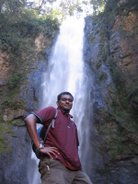New reactor technologies offer poorer nations cheap, safe, efficient power. Sanctions designed to prevent the proliferation of weapons impede their use. What would a better policy look like?
By Mark Williams

Heavy water: Cutaway of the ESBWR, which probably represents the ultimate in what can be done to achieve simplicity of design in a water-cooled reactor; window at right depicts the reactor’s circulatory system.
Atambir Rao, a nuclear engineer who spent nearly two decades as program manager for General Electric's next-generation nuclear-reactor design, believes that the countries that are most in need of nuclear power are developing countries like his birthplace, India. Rao says, "Today, the biggest challenge for nuclear is the stranglehold the developed nations have put on it with sanctions."
The reactor project whose development Rao led was the Economic Simplified Boiling Water Reactor (ESBWR), one of the generation-III nuclear-reactor designs that incorporate the improved fuel technology and passive safety systems--whereby the reactor automatically shuts down safely in any emergency without operator action or electronic feedback--that have been developed over the past quarter century. In 2007, with multitudes in India and China approaching lifestyles comparable to those in the developed nations, and with planetary climate change from carbon-dioxide emissions increasingly manifest, it's worth stressing that nuclear power remains the sole existing energy technology that's both proven and zero carbon. The critical question for the technology's future is whether the forbiddingly high capital costs and lengthy construction times attached to it in the past still apply.
In fact, gen-III reactors like the ESBWR do seem to possess the relative cheapness and ease of construction necessary for nuclear power to potentially establish itself as the primary electrical generation technology for national grids, both in the developed world and in countries like China and India. Per Peterson, UC Berkeley professor of nuclear engineering and part of the team responsible for the ESBWR, says that the design represents a reduction in capital costs of 25 to 40 percent. "In terms of competing with coal-burning plants, that's significant," he says. "If you can displace coal with less expensive options, then it becomes a different future." Peterson adds a couple of qualifiers: "Over the last year, costs have risen for all the energy technologies due to rising commodity costs. So both coal and nuclear cost estimates have been growing. On the other hand, I think we've now reached the tipping point on climate-change legislation. If we get carbon controls, there's no question the equation changes." In other words, carbon controls would go some way toward building into the use of fossil-fuel-burning power plants the externalities, or hidden costs, currently not included in consumers' utility bills or paid for by the power companies.
Today, reactor design has more than a half-century of art behind it, so gen-III reactors resemble their 1970s-era generation-II predecessors, much as a Toyota Prius hybrid resembles a vintage 1972 Pontiac, with the progressive trend being toward radical simplification that eliminates the batteries of complex mechanisms built into the earlier designs. The ESBWR replaces previous reactors' complex systems for residual heat removal with a design that uses no pumps or emergency generators--in fact, it possesses no moving parts at all, except for the neutron-absorbing control rods that are pulled partway out from its core so that nuclear fission can proceed. That fission reaction boils the water in the ESBWR's core, which becomes steam that gets carried away to large tubes in which it rises, releases its energy to turbines, and then condenses so that gravity causes it to flow back down to the core as water again. In short, the ESBWR runs wholly on natural circulatory forces. Rao says, "It could not be simpler. The control rods get pulled out, water comes in, and steam goes out, carrying heat that gets turned into electricity."
Further read... Nuclear Energy for the Developing World

No comments:
Post a Comment